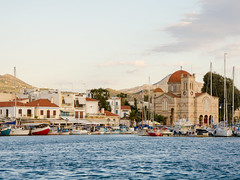Aegina Travel Guide

Aegina or sometimes spelt Aigina (Greek Αίγινα) is an island in the Saronic Bay, at a distance of only 27 km from the port of Piraeus (or Pireas). Aegina has a surface of 87.41 km2 and a population of 13,552 inhabitants as of 2001. The main town and port of the island, which bears the same name, is home to 7,743 inhabitants. Some of the island’s smaller towns and villages are Kypseli (1,949 inhabitants), Mesagros (1,603 inhabitants), Perdika (743 inhabitants) and Vathy (1,474 inhabitants).
Aegina is well-known for the ancient Temple of Aphaea, which is located at an equal distance from the Parthenon in Athens and the Temple of Poseidon in Sounio, the three of them forming an equilateral triangle on the map. Aegina was the first capital of the State of Independent Greece, followed by Nafplio (1829–1833) and finally Athens (1834–today).
Aegina is a very popular touristic destination owing to its beauty and its proximity to Athens. The main income source on the island comes primarily from tourism followed by agriculture. Aegina is well-known all around the globe for its delicious pistachio nut (Pistachia vera). Pistachio nuts grow on trees, harvested around the end of August until middle of September and are usually roasted and served as an accompaniment to drinks or even used raw in cooking and baking.
Places to visit
- the main town and port of Aegina
- the villages of Perdika, Vagia , Souvala and Aghia Marina (or Agia Marina)
- the beaches of Marathonas (two distinct beaches in one bay), Aghia Marina, Sarpa, Kleidi, Aeginitisa, and Portes
Monuments and Museums to visit
- the Temple of Afaea or Afaia (fifth century BC) and its museum with ancient sculptures and pottery
- the remains of the Temple of Zeus Panhellenius (built between the eleventh and twelfth century BC, it is probably Europe's oldest altar) at the foot of the island's highest mountain, Mount Ellanion Oros (532 metres elevation); the region is included in the top 500 places of historical importance and natural beauty in Greece and the 24th most important destination in the prefecture of Attica, and it is protected by a law of the Greek State
- the Temple of Apollo (sixth century BC) and its museum with ancient sculptures and pottery from the island, featuring the biggest ancient Greek amphora that has been found until today
- the medieval town of Palaia Chora, built on a hill to have view over the surrounding sea and protection against pirates
- the museum of the famous sculptor and painter Christos Kapralos, which is part of the National Gallery and Alexandros Soutzos Museum located in Athens
- the Tower of Markellos, built in AD 1803 by Spyridon Markellos. During the governance of Ioannis Kapodistrias, the tower housed the Governor-Lieutenancy Commission and the National Fund of the Greek State. Nowadays, it is home for the Ioannis Kapodistrias Cultural Centre and the Spyros Alexiou Foundation
- the Hellenic Wildlife Hospital, which cares for the treatment, rehabilitation and release of all species of wildlife indigenous to Greece, and raises awareness about wildlife and its importance
- The Government house (Kyverneio), which housed the first Government of the State of Independent Greece (1828–1829)
- the Orphanage, built by Ioannis Kapodistrias as a shelter and school for orphans. Later, the building housed the first archaeological museum, the first National Printing house, the lithographic, the library and the first Greek school of Music.
Events to attend
- the Fistiki Fest, which takes places around the middle of September and is a great opportunity to get to know the pistachio nut, its uses and also learn about the traditions of the island (Read more about the fistiki fest)
- the International Music Festival of Aegina taking place between August and September and usually lasts for roughly a month
Food and Drinks to taste
- pistachio nuts and anything involving them, such as pasteli made with pistachio and honey, as opposed to the typical version of this sweet, made with sesame and honey or sesame and sugar
- fresh fish
- seafood, such as octopus, calamari and prawns
pasteli
Map of Aegina with accommodations
The blue markers shows the location of various accommodations in Aegina. The letter in the marker describes the accommodation types: H for Hotel, A for Apartment, R for Resort, B for Bed & Breakfast and O for Other (e.g. pension, villa). Click on the blue marker for more information on the accommodation.










